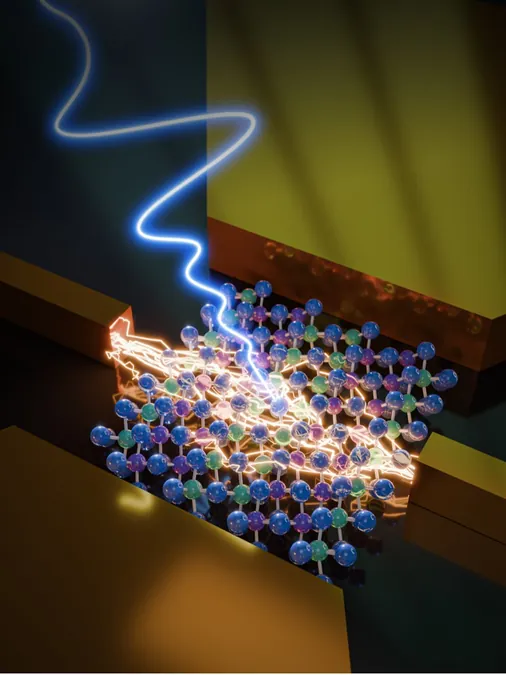
Revolutionizing THz Sensing: The Breakthrough of TaIrTe₄ Photodetectors
2025-07-03
Author: Mei
Unlocking the Potential of Terahertz Radiation
Imagine a world where terahertz (THz) radiation—electromagnetic waves that range from 0.1 to 10 THz—transforms technologies from imaging systems to cutting-edge communication networks. Until now, progress has been stymied by the scarcity of advanced detectors capable of accurately and sensitively capturing this fertile frequency range.
A Game-Changer in Sensing Technology
A groundbreaking study published in *Nature Electronics* by researchers from the University of Wisconsin-Madison, the University of Tennessee, and other research institutes introduces a revolutionary class of photodetectors made from tantalum iridium telluride (TaIrTe₄)—a remarkable 2D-correlated topological semimetal. This innovative material boasts a unique nonlinear Hall effect, producing a transverse voltage independent of external magnetic fields.
As Jun Xiao, the senior author of the study, highlighted, "The importance of THz technology extends to quantum information and biomedical sensing, as it resonates with molecular vibrations and low-energy excitations in quantum materials. The potential for high-speed wireless communication is immense, yet we are limited by the lack of effective THz detection technologies. This is where our new photodetectors come in."
Overcoming Limitations with TaIrTe₄
Current THz photodetectors fall short on critical metrics—they’re either too slow, lack sensitivity, or can only detect a narrow frequency range. The researchers aimed to create devices that defy these limitations. By deploying atomically thin layers of TaIrTe₄, they crafted novel sensors and tested them under THz radiation.
"We meticulously measured the photocurrent generated and evaluated our devices for responsiveness and sensitivity. Our findings revealed speed capabilities in the picosecond range," explained Xiao.
Unveiling New Phases for Enhanced Performance
The research team didn’t stop there; they also explored TaIrTe₄'s crystal symmetry using second-harmonic generation spectroscopy. This technique unveiled a correlated electronic phase at lower temperatures, significantly enhancing the material's responsiveness to THz radiation.
Stellar Performance Metrics
In preliminary tests, these photodetectors demonstrated impressive capabilities, achieving zero-bias responsivity around 0.3 A/W, ultra-low noise equivalent power (~pW/Hz¹/²), and a extensive frequency response from 0.1 to 10 THz. They also exhibited phenomenal intrinsic speeds.
Moreover, the responsivity surged by about 50 times to an astounding 18 A/W when the topological semimetal transitioned into a correlated charge ordering. This breakthrough leverages advanced topological physics and quantum attributes, setting a new standard for THz detectors compared to traditional technologies.
Paving the Way for Future Innovations
Looking ahead, the research team envisions that their photodetectors could spearhead significant advancements in THz sensing technologies. Xiao mentioned that the next phase would not only focus on single THz sensing devices but also on developing expansive imaging arrays.
Excitingly, they plan to integrate machine learning algorithms with the tunable properties of TaIrTe₄ to create intelligent THz sensing systems that could revolutionize applications across various fields.
A New Era in THz Detection Awaits!
With the advent of these remarkable TaIrTe₄ photodetectors, we stand on the brink of a new era in THz detection technologies. The skies are no longer the limit as researchers aspire to unlock real-world applications, potentially transforming industries and scientific research alike. Stay tuned!



 Brasil (PT)
Brasil (PT)
 Canada (EN)
Canada (EN)
 Chile (ES)
Chile (ES)
 Česko (CS)
Česko (CS)
 대한민국 (KO)
대한민국 (KO)
 España (ES)
España (ES)
 France (FR)
France (FR)
 Hong Kong (EN)
Hong Kong (EN)
 Italia (IT)
Italia (IT)
 日本 (JA)
日本 (JA)
 Magyarország (HU)
Magyarország (HU)
 Norge (NO)
Norge (NO)
 Polska (PL)
Polska (PL)
 Schweiz (DE)
Schweiz (DE)
 Singapore (EN)
Singapore (EN)
 Sverige (SV)
Sverige (SV)
 Suomi (FI)
Suomi (FI)
 Türkiye (TR)
Türkiye (TR)
 الإمارات العربية المتحدة (AR)
الإمارات العربية المتحدة (AR)